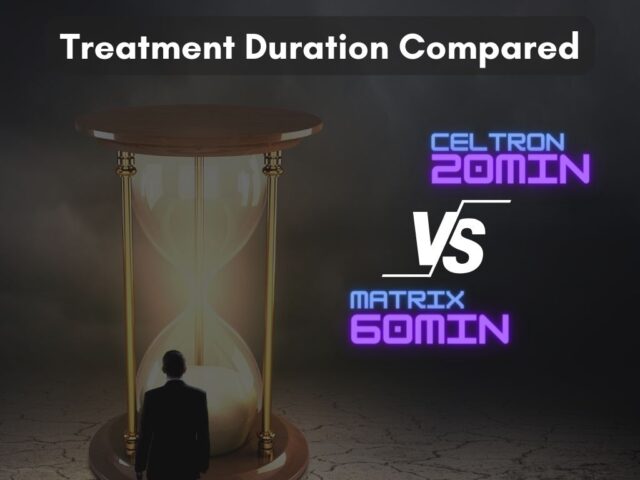In this next leg of our journey through the world of physiotherapy devices, we’re about to dive into something that truly matters – treatment duration and financial considerations. Buckle up because we’re about to uncover how Matrix Therapy, Magneto, and Celtron stack up when it comes to ensuring efficient treatments and smart financial decisions.
Ever wondered how these devices impact your treatment sessions and your bottom line?
Let’s explore how these devices can streamline your practice and make every session count……
Treatment Duration and Its Impact on Patient Scheduling
In the world of physiotherapy, time is often the fulcrum that keeps your practice running smoothly. How long a treatment takes can influence patient scheduling, clinic efficiency, and ultimately, your success.
In this segment, we’re diving headfirst into treatment duration – how it affects your daily schedule, patient comfort, and practice profitability. We’ll explore the implications of Matrix Therapy, Magneto, and Celtron devices on your ability to provide quality care while optimizing your clinic’s operations.
Let’s roll up our sleeves and dissect this crucial aspect of physiotherapy.
Session Duration Showdown: Matrix Therapy vs Magneto vs Celtron
Alright, fellow physiotherapists, let’s cut straight to the chase – session duration is a critical factor in managing your patient load and delivering effective care. In this showdown between Matrix, Magneto, and Celtron, we’re going to dissect the treatment times and what they mean for your practice.

Matrix Therapy: Matrix Therapy, while efficient in its own right, demands a bit more of your time. With a standard session duration of 1 hour, it’s essential to factor this into your scheduling. While the treatment is effective, the longer duration can limit the number of patients you can see in a day.
PEMF/Magneto: On the flip side, Magneto offers a more time-efficient option. With a session duration of around 30 minutes, it allows you to see more patients while maintaining quality care. However, keep in mind that some patients may benefit from longer sessions.
Celtron: Celtron takes the lead here with a session duration of average 20 minutes. This not only means shorter waiting times for your patients but also the potential to see more patients in a day without compromising quality. The shorter session duration can also be beneficial for patients who prefer quicker treatments.
In the realm of session duration, Celtron emerges as the frontrunner, offering efficient treatments that maximize your patient load while ensuring optimal care. However, the choice ultimately depends on your patient demographics and practice goals.
Scheduling Implications and Efficiency Considerations
Now that we’ve dissected session durations, it’s time to roll up our sleeves and get into the nitty-gritty of scheduling. After all, a well-planned schedule can make or break your clinic’s efficiency. Let’s dive into the scheduling implications and efficiency considerations when it comes to Matrix Therapy, Magneto, and Celtron.
Matrix Therapy: With a session duration of 1 hour, Matrix can be a bit of a time hog. While it offers effective treatments, it’s essential to allocate ample time for each patient. This might translate to fewer patients seen in a day compared to quicker treatments.
PEMF/Magneto: Magneto’s 30-minute sessions offer more flexibility in scheduling. You can comfortably accommodate more patients in your daily roster without compromising on care quality. Plus, shorter wait times are a win in the patient satisfaction department.
Celtron: Celtron’s 20-minute sessions are a game-changer in terms of efficiency. You can schedule back-to-back appointments with minimal gaps, ensuring that your clinic runs like a well-oiled machine. This not only maximizes your patient load but also minimizes waiting times.
Efficient scheduling isn’t just about seeing more patients; it’s about optimizing your practice’s profitability and ensuring patients receive timely care. In this aspect, Celtron’s shorter treatment duration shines, offering both you and your patients a win-win situation.
Patient Comfort and Session Effectiveness
When it comes to patient comfort, Matrix Therapy, Magneto, and Celtron offer different approaches that can affect not only how your patients feel but also their overall experience.

Matrix Therapy: Matrix provides effective treatments, but its longer session duration might be a concern for some patients. However, it’s important to note that some patients might find this extended time as an opportunity for relaxation, potentially enhancing their overall experience.
PEMF/Magneto: Magneto’s 30-minute sessions strike a balance between effectiveness and patient comfort. Patients often find this duration manageable and less taxing, both physically and mentally. It’s not just about comfort but also optimizing the use of their time.
Celtron: With its 20-minute sessions, Celtron takes the lead in patient comfort and session effectiveness. The shorter duration isn’t just about comfort; it’s about maximizing the use of both your and your patient’s time. Patients can achieve the same or even better results in less time, which is not only convenient but also cost-effective for them.
Celtron’s approach aligns with the modern pace of life, where time is a precious commodity. Shorter sessions not only keep patients comfortable but also make physiotherapy more accessible, efficient, and cost-effective. This can lead to higher patient satisfaction and better treatment adherence.
Financial Insights for the Savvy Physiotherapist

Hello, fellow physiotherapists,
In our quest to provide the best care for our patients, financial considerations are a crucial aspect of running a successful practice. In this section, we’re delving deep into the financial aspects of Matrix Therapy, Magneto, and Celtron devices. From upfront costs to long-term value, we’re here to help you make informed decisions that not only benefit your patients but also your bottom line.
Let’s dive into the financial side of physiotherapy and uncover the insights that can elevate your practice.
Upfront Cost Comparison: Matrix Therapy vs. Magneto vs. Celtron
Let’s talk money – because, in the world of physiotherapy, it matters. We’ll break down the upfront costs of Matrix, Magneto, and Celtron to help you make a wise investment choice.
Matrix Therapy: With a cost of around INR 5 lacs, Matrix falls in the mid-range when it comes to upfront costs. While it may require a significant initial investment, its effectiveness might make it a worthwhile choice for some practices.
PEMF/Magneto: Magneto, on the other hand, falls in a range of INR 4 lacs to 8 lacs with devices from various manufacturers in India and abroad. This places it on the higher end of the cost spectrum. You’ll need to weigh the benefits it offers against the upfront expense.
Celtron: Celtron takes the lead in this financial battle, with an initial cost of just INR 3.5 lacs. Not only is it the most cost-effective option, but it also offers a range of features that can benefit your practice and patients. Also Celtron has an option of two applicators combining Matrix Therapy and PEMF Therapy in one device. If a physio purchases two above equipments, the total cost will be more than 10 lacs. The combined cost of Celtron is just INR 4.5 lacs. It’s a steal deal for physiotherapists in India.
Remember, while upfront costs are a significant factor, they’re just one piece of the puzzle.
Long-Term Value Assessment
Now that we’ve tackled the upfront costs, let’s shift our focus to the long-term value these devices offer. After all, a sound investment in your practice should pay off in the years to come.

Matrix Therapy: Matrix, with its mid-range upfront cost around 5 lacs, provides value through its effectiveness in treatments. It’s essential to consider how its long-term performance and reliability align with your clinic’s goals.
PEMF/Magneto: Magneto, while having a higher upfront cost, could potentially offer long-term value if it consistently delivers exceptional results and stands the test of time. It’s crucial to assess how it fits into your practice’s financial projections.
Celtron: Celtron shines in terms of long-term value, not just because of its cost-effective initial investment of 4 lacs only, but also due to its innovative features and potential for improved patient outcomes. Consider how Celtron’s unique advantages can contribute to your practice’s success over time.
When evaluating long-term value, it’s essential to look beyond the initial expense and assess how each device aligns with your practice’s growth and patient satisfaction objectives.
Breakdown Cost Analysis: Financial Risks of Malfunctions
While the initial costs are vital, let’s not forget about the potential financial pitfalls that can arise from device malfunctions. Understanding the breakdown costs is crucial to safeguard your practice’s financial health.
Matrix Therapy: Matrix therapy, with its initial cost of 5 lacs, may come with maintenance and repair expenses over time. Importantly, servicing Matrix can be costlier and time-consuming, directly affecting your practice’s efficiency and patient care.
PEMF/Magneto: Magneto might entail significant repair costs if technical issues arise. Similar to Matrix Therapy, it can consume precious time for repairs, impacting both your practice and patient satisfaction.
Celtron: Celtron, with its cost-effective initial investment of just 4 lacs, offers an advantage not only in upfront expenses but also in potential breakdown costs. Its “Made-in-India” tag often translates to easier access to local service, minimizing financial risks and ensuring efficient care for your patients.
When evaluating breakdown costs, think about the impact on your practice’s finances and patient care. A device that can be serviced efficiently and cost-effectively can be a game-changer in maintaining your clinic’s reputation and financial stability.
ROI Examination: Patient Volume vs. Treatment Cost
Now, let’s dive into the heart of your practice – the Return on Investment (ROI). Your choice of physiotherapy device should not only improve patient care but also contribute to your bottom line.
Matrix Therapy: Matrix therapy, with its 5 lacs initial cost, may require a higher patient volume to justify the investment. Consider how many additional sessions or patients it would take to cover the expenses.
PEMF/Magneto: Magneto, with a higher upfront investment and low returns, presents a more substantial financial hurdle. Assess whether your practice can generate enough patient volume to make this device financially viable.
Celtron: Celtron, priced around 4 lacs initially, offers a cost-effective solution that may require fewer patients to achieve a positive ROI. Its affordability can directly impact your practice’s financial success.
When examining ROI, think about how each device’s cost aligns with your patient volume and the treatments it can offer. Your investment should not just enhance patient outcomes but also boost your clinic’s financial well-being.
Stay tuned as we explore Celtron’s unique advantages in the next article.
Read More:
1. The Article 1 : Matrix Therapy vs Magneto vs Celtron: The Ultimate Guide
Frequently Asked Questions (FAQ)
As a clinical Physical Therapist, how do I evaluate the long-term value of investing in Matrix Therapy, Magneto, or Celtron devices for my physiotherapy practice?
To evaluate the long-term value of investing in Matrix Therapy, Magneto, or Celtron devices, consider factors such as the initial cost, the range of therapies offered, session durations, and potential patient outcomes. Assess how each device can enhance your clinic’s efficiency and patient satisfaction over time.
How do session durations compare between Matrix, Magneto, and Celtron devices?
Matrix has a session duration of 1 hour, Magneto sessions last 20-30 minutes, and Celtron requires the shortest duration of 20 minutes.
How does session duration affect patient scheduling in physiotherapy clinics using Matrix Therapy, Magneto, or Celtron?
Session duration significantly affects patient scheduling; Celtron allows for the most efficient scheduling with its 20-minute sessions, while Matrix requires more extended slots due to its 1-hour session duration, potentially reducing the number of daily appointments.
How do the session durations of Matrix, Magneto, and Celtron influence patient satisfaction?
Shorter session durations, as seen with Celtron, often lead to higher patient satisfaction due to reduced waiting times, more efficient treatments and early results.
What are the upfront costs of Matrix, Magneto, and Celtron devices?
Matrix is priced at around INR 5 lacs, Magneto/PEMF between 4-8 lacs, and Celtron is the most affordable option at 4 lacs, offering a cost-effective solution for physiotherapy clinics.
Which physiotherapy device offers the best long-term value: Matrix Therapy, Magneto, or Celtron?
Celtron indeed offers the best long-term value due to its affordable initial cost and innovative features that aim to improve patient outcomes, providing a broader spectrum of treatment options.
What potential financial risks should be considered when purchasing a Matrix Therapy, Magneto, or Celtron device?
When purchasing a Matrix, Magneto, or Celtron device, consider the upfront costs, potential breakdown costs, and the availability and cost of servicing and maintenance.
What should physiotherapy practitioners consider regarding the breakdown costs of Matrix, Magneto, and Celtron devices?
Physical Therapists should consider potential repair costs and service accessibility. Matrix and Magneto may incur higher breakdown costs and longer repair times compared to Celtron, which benefits from easier access to local service and spare parts.
How does the Made-in-India tag of the Celtron device benefit physiotherapy practices in terms of service and maintenance?
The Made-in-India tag of the Celtron device ensures easier access to local service and maintenance, potentially reducing downtime due to malfunctions and keeping repair costs lower compared to international brands.
Which device between Matrix, Magneto, and Celtron offers the quickest return on investment?
Celtron potentially offers a quicker ROI due to its lower initial cost and the ability to accommodate a higher number of patients daily, thus potentially increasing clinic revenue.
How do Matrix Therapy, Magneto, and Celtron devices compare in terms of treatment effectiveness?
All three devices are designed to offer effective treatments, but they differ in session durations and features, with Celtron offering innovative solutions aimed at improving patient outcomes in shorter time frames.
Which physiotherapy device is the most cost-effective: Matrix Therapy, Magneto, or Celtron?
Celtron is the most cost-effective option with an initial price of 4 lacs, coupled with features that facilitate efficient scheduling, patient satisfaction and potentially quicker returns on investment.
How to achieve professional growth of a physiotherapy clinic?
Achieving professional growth in a physiotherapy clinic involves a multifaceted approach. Firstly, investing in advanced devices such as Matrix Therapy, Magneto, or Celtron can enhance treatment effectiveness and patient satisfaction.
For instance, opting for a device like Celtron can offer shorter treatment durations, allowing you to serve more patients efficiently.
Secondly, focusing on financial prudence by considering both the upfront and long-term value of the equipment can aid in sustaining growth.
Lastly, maintaining a high standard of patient care, facilitated by the right choice of device, can foster a positive reputation, encouraging patient retention and attracting new clients through word-of-mouth and positive reviews. It is essential to continually update your practice with the latest technologies and therapies to stay competitive and foster growth.
0 Comments